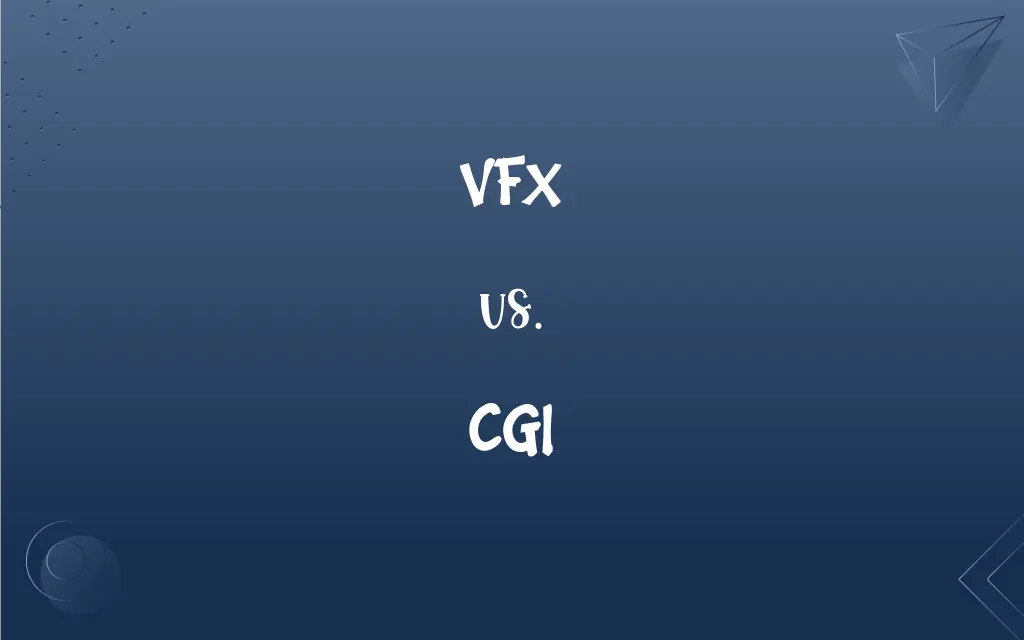VFX vs. CGI: What's the Difference?
Edited by Aimie Carlson || By Janet White || Published on February 13, 2024
VFX (Visual Effects) are methods to create or enhance imagery in filmmaking, while CGI (Computer-Generated Imagery) is a type of VFX created exclusively using computer software.

Key Differences
Visual Effects (VFX) are techniques used to create or manipulate imagery outside the context of a live-action shot in filmmaking. Computer-Generated Imagery (CGI), a subset of VFX, specifically refers to imagery created using computer software. VFX encompasses both CGI and other methods like practical effects.
VFX is a broad term that includes all methods used to create visual effects in films, television, and other media, including but not limited to CGI. CGI is used to generate 3D images, animations, and visual scenes that are difficult or impossible to capture with real-world filming.
VFX often combines real footage with modified imagery to enhance the realism of the scene. CGI, however, is usually entirely computer-generated, aiming to integrate seamlessly with live-action footage but can be distinguished due to its artificial origin.
VFX can be implemented in post-production or during filming (like chroma keying). CGI, as a part of VFX, is typically created and applied in the post-production phase, requiring significant computing resources.
VFX has evolved from traditional techniques like matte painting and model-making to include digital methods, with CGI being the forefront of this evolution. CGI technology has revolutionized filmmaking by allowing for the creation of complex and dynamic visual scenes.
ADVERTISEMENT
Comparison Chart
Definition
Techniques to create/enhance imagery in filmmaking.
Specific type of VFX created using computers.
Scope
Includes CGI and practical effects.
Exclusively computer-generated.
Usage in Production
Can occur during or after filming.
Typically occurs in post-production.
Realism
Combines real and modified imagery.
Entirely computer-generated.
Evolution
Evolved from traditional to digital techniques.
Represents the advanced digital aspect of VFX.
ADVERTISEMENT
VFX and CGI Definitions
VFX
VFX includes both digital and practical effects.
The film combined practical explosions with VFX for dramatic scenes.
CGI
CGI often involves 3D modeling and animation.
CGI was used to animate characters in the animated film.
VFX
VFX can be applied in both pre-production and post-production.
Pre-visualization VFX helped in planning complex action sequences.
CGI
CGI requires extensive use of computer software and hardware.
High-end computers rendered the CGI effects in the sci-fi movie.
VFX
VFX are techniques to create visual effects in film and TV.
The movie used VFX to create realistic alien landscapes.
CGI
CGI is used for creating scenes or elements not feasible in reality.
The futuristic cityscape was entirely CGI.
VFX
VFX enhances or alters footage shot during production.
VFX was used to add crowds in the stadium scenes.
CGI
CGI is the creation of computer-generated imagery.
The dragon in the movie was a masterpiece of CGI.
VFX
VFX often integrates CGI with live-action footage.
The superhero's powers were created using VFX.
CGI
CGI is a subset of VFX used exclusively in digital form.
The film's special effects team used CGI for the monster's movements.
FAQs
What is VFX?
VFX refers to the process of creating or manipulating imagery outside the context of a live-action shot in filmmaking.
How has VFX evolved over time?
VFX has evolved from simple techniques like matte paintings to complex digital effects and 3D modeling.
Is VFX only used in movies?
No, VFX is also used in TV shows, video games, and virtual reality.
How is VFX different from CGI?
VFX includes any kind of visual manipulation in post-production, whereas CGI is specifically about creating computer-generated imagery.
Can VFX be done in real-time?
While challenging, real-time VFX is becoming more common, especially in live events and video games.
Are practical effects a part of VFX?
Practical effects are physical effects used on-set; they can be complemented by VFX in post-production.
What software is commonly used for VFX?
Adobe After Effects, Nuke, and Autodesk Maya are among the popular VFX software.
Can VFX be learned online?
Yes, there are many online courses and tutorials available for learning VFX.
How is CGI used in movies?
CGI is used to create animated characters, environments, and visual effects.
What’s the difference between CGI and 3D animation?
CGI is a broad term that includes 3D animation, but it also encompasses 2D graphics and visual effects.
What are common uses of VFX?
VFX is used for creating realistic environments, enhancing backgrounds, and integrating special effects that are impractical or impossible to capture on film.
Can CGI replace traditional filmmaking methods?
While CGI offers many possibilities, it often complements rather than replaces traditional filmmaking methods.
How has CGI impacted the film industry?
CGI has revolutionized the film industry, allowing for more creative and visually dynamic storytelling.
What is CGI?
CGI is the creation of still or animated visual content with computer software.
What skills are needed for creating CGI?
Skills in 3D modeling, texturing, rigging, and animation are essential for creating CGI.
Are video games considered CGI?
Yes, video games extensively use CGI for creating characters, environments, and effects.
How important is VFX in modern filmmaking?
VFX is crucial in modern filmmaking for creating visually stunning and imaginative scenes.
Is CGI expensive to produce?
CGI can be expensive, depending on the complexity and quality of the imagery required.
What are some limitations of CGI?
CGI can be limited by budget, technology, and the need for it to look realistic and integrate seamlessly with live-action footage.
How long does it take to create CGI for a movie?
The time can vary greatly, from weeks to years, depending on the complexity and scope of the project.
About Author
Written by
Janet WhiteJanet White has been an esteemed writer and blogger for Difference Wiki. Holding a Master's degree in Science and Medical Journalism from the prestigious Boston University, she has consistently demonstrated her expertise and passion for her field. When she's not immersed in her work, Janet relishes her time exercising, delving into a good book, and cherishing moments with friends and family.
Edited by
Aimie CarlsonAimie Carlson, holding a master's degree in English literature, is a fervent English language enthusiast. She lends her writing talents to Difference Wiki, a prominent website that specializes in comparisons, offering readers insightful analyses that both captivate and inform.































































